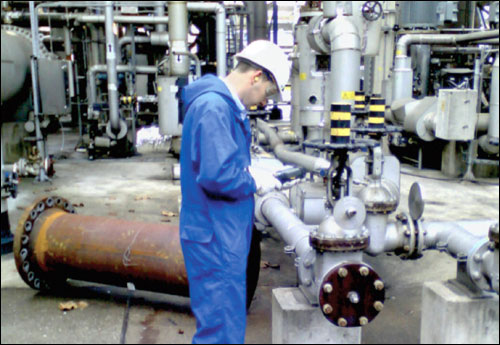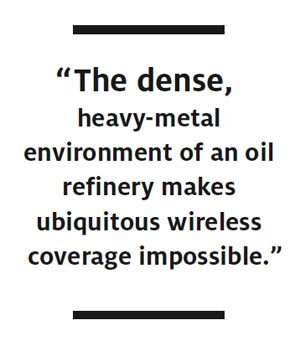Jun 01, 2012BP operates 11 oil refineries worldwide and each must undergo scheduled maintenance. During these operations, called turnarounds (TARs), parts of a facility are closed for up to 30 days, so the company can inspect, clean and repair equipment. In addition, BP performs plant upgrades and other improvements. TARs are labor-intensive, expensive and potentially hazardous operations.
Before any TAR-related work can be performed, the designated section of the plant must be shut down, then purged of hydrocarbons and allowed to cool. This ensures there are no lingering pockets of hydrocarbons or other explosive or flammable materials. In the end, each part of the refinery is "isolated" from connected equipment, to prevent material from one part of the facility from entering another.
These isolations involve a number of processes, including disconnecting pipes at the flanges (the components that connect the pipes) and fitting blinds (large metal discs) into the flanges. This effectively shuts off the pipes, so engineers can tackle the maintenance work safely.
What makes the task so challenging is that the isolations must take place in a specific sequence, and blinds must be matched to specific pipe flanges. A recent TAR, for example, required 6,400 isolations—and the entire process had to be carried out at the beginning of the TAR and then reversed before the plant could be brought back into operation. Simply put, every blind must be fit correctly and then extracted in the proper order.
In September 2010, BP introduced an RFID solution called Isolation Tracker at its refinery in Gelsenkirchen, Germany, to make isolation processes faster, more accurate and safer. The solution controls TAR tasks, ensuring work processes occur in the correct sequence and maintenance workers isolate the right equipment. It also maintains accurate records and provides updates in near-real time.
Isolation Tracker has reduced contractor costs and generated revenue from increased plant uptime—saving approximately $1 million per turnaround, according to Mike Haley, a consultant in the chief technology office of BP's Information Technology & Services group. The mobile application has become part of the toolset used for TARs and is already in operation at a second BP refinery in Germany. "This project has helped create a new standard for the way we work in the plant," Haley says.
BP is no newcomer to RFID. For the past several years, the company has used an RFID-based mobile application called Task Tracker to manage assets and tasks, including the maintenance of pipes and other equipment at its refineries and platforms. The idea of using a mobile RFID application for TAR isolations came from a plant operator at the Gelsenkirchen refinery. "He recognized that by extending the use of the mobile application with integral RFID, we could address a much bigger opportunity to work faster and more accurately, reduce paper and improve the safety level of isolations," Haley says.
The spreadsheet and paper-based system the company was relying on contributed to a less-than-efficient workflow, Haley notes. "At other sites, where we used bar-code tags, we found that they would not last more than a few years," he says. "This meant that we would have a maintenance task ahead of each shutdown or large maintenance activity just to make sure the bar codes were still in place and readable."
The first step, Haley says, was to establish an internal crossfunctional team, to understand the requirements and identify benefits and challenges. The BP CTO team served as the internal project consultancy and helped identify technology solutions. Other participants included an IT manager and project leader who focused on implementing the project on site and testing various systems; maintenance and operations managers; and a software developer who handled local mobile software development and integration with the company's SAP enterprise resource planning (ERP) system. BP used a Syclo Agentry platform for the mobile application, as well as to connect to SAP. An outside consultant wrote the SAP-based back-end control-of-work (CoW) software to fit BP's requirements and standards.
BP installed a Wi-Fi network and applied roughly 150,000 Tectus high-frequency RFID tags on flanges, blinds and other equipment, according to Haley. Each tag was tested and printed with an I-Safe Atex Zone 1 nonerasable stamp, for use in hazardous environments. Then, each tag was crossreferenced and checked to match the equipment asset record in a SAP plant-maintenance ERP application. As a result, each maintenance work order created contains the RFID number of the associated asset.
Maintenance fitters and electricians receive their assignments, at the plant, on eCom iRoc Atex Zone 1 Intrinsically Safe handheld computers with integrated HF RFID readers—they no longer have to go to the control room to receive each assignment. They initiate each task by scanning a tagged asset. The tag triggers the work order assigned to the worker, and the specific tasks associated with that piece of equipment appear on the handheld's screen. The worker confirms the start of the task. If the wrong asset is scanned, no work order appears and the task cannot be initiated, preventing mistakes. The solution also eliminates the trial-and-error process of deciding which blind fits a particular pipe flange, Haley says.
Once the worker completes the job and enters the relevant information in a handheld, an inspector is alerted to inspect the work and sign off wirelessly. The back-end CoW system is updated in near-real time. The lead operator in the control room monitors the status of all the isolations on a CoW Cockpit screen, and alerts the TAR maintenance crews when it's safe to commence work. "The system recognizes that multiple tradespeople may be involved, and tasks can be dependent on each other," Haley says. A blind, for example, cannot be fit until its pipe has been purged and the pump has been electrically isolated.
BP conducted extensive testing off-line before deploying the technology at the refinery. The project team also focused on system integration, to ensure that a new dashboard designed to track activities would update in real time, so the control-room operator could use it to manage work in the plant. The team also tested various RFID tags and handheld reader combinations to find the most reliable pairing.
Not surprisingly, the field trial presented a number of formidable challenges. First, there was the task of attaching the RFID tags to large metal blinds and pipe flanges and making sure they would stay in place. "We tested industrial-strength glues before we finally found a glue capable of permanently attaching the tags to the solid metal blinds," Haley says.
The flanges presented a different problem. "We couldn't glue tags on, because some pipe flanges are covered with a removable insulation," Haley says, explaining that tagging the insulation was not a reliable option because the insulation could be replaced or reinstalled in a different place following a TAR. The BP team solved the problem by encircling the entire pipe flange and insulation with a thin, tamperproof wire and affixing the tags to it. "The wire stays in place whether the insulation is on or off the pipe," Haley notes.
Then, there was the problem of connecting to the Wi-Fi network within the refinery and relaying data back to the control room. Unfortunately, the eCom iRoc handhelds couldn't pick up the Wi-Fi signal throughout the plant. "The dense, heavy-metal environment of an oil refinery makes ubiquitous wireless coverage impossible," Haley says.
RFID Fuels Results
It took nearly one year to develop, test and fully implement the RFID solution. Maintenance workers received classroom training, and many found the system intuitive, Haley says. Since Isolation Tracker was deployed, no isolation problems have been reported. This reflects increased safety and efficiency. The system has been proposed as a standard for all BP refineries, Haley notes.
BP is now looking for ways to expand the scope of the project. The original application has already been extended further into the CoW system used in conjunction with SAP, Haley says. With this integration, the company has a more comprehensive view of maintenance activities. BP also is testing the solution at a production facility near Edinburgh, Scotland, and if this project goes well, the firm plans to introduce the RFID solution at offshore oil platforms in the North Sea.
Haley expects the RFID system to become faster and better during the next few years, as the company adopts the next generation of handheld devices and further refines its processes. "This project set a new standard for mobile applications," he says. "It makes the workplace safer and ensures accurate collection of data in our industrial setting. This project has been very important in showing that applications built on a good RFID infrastructure really deliver value."


